Research on the Construction of a Composite Humanistic Forest Ecological Corridor in the Main Urban Area of Daqing City
Abstract
1. Introduction
2. Materials and Methods
2.1. Study Area Overview
2.2. Data Sources and Pre-Processing
2.3. Research Methodology
2.3.1. MSPA-Based Ecological Source Site Identification
2.3.2. Ecological Resistance System Construction
2.3.3. Extraction of Ecological Routing Based on MCR Modeling
2.3.4. Open Space Resource Point Identification and Functional Evaluation System Construction
2.3.5. Recreational Route Selection Extraction Based on GIS Network Analysis
3. Results and Analysis
3.1. Identification of Source Lands and Extraction of Line Selection Based on Ecological Protection Perspectives
3.2. Resource Identification and Line Selection Extraction Based on Recreational Perspective
3.3. Construction of Composite Forest Ecological Corridors
4. Discussion
5. Conclusions
Author Contributions
Funding
Institutional Review Board Statement
Informed Consent Statement
Data Availability Statement
Acknowledgments
Conflicts of Interest
References
- Zhou, Q.; Konijnendijk van den Bosch, C.C.; Chen, J.; Zhang, W.; Dong, J. Identification of ecological networks and nodes in Fujian province based on green and blue corridors. Sci. Rep. 2021, 11, 20872. [Google Scholar] [CrossRef] [PubMed]
- Hong, T.; Li, L.; Wang, B. The Planning and Construction Path of Innovative and Intelligent Park Cities Based on Big Data Technology. Math. Probl. Eng. 2022, 2022, 6049677. [Google Scholar] [CrossRef]
- Xu, X.; Wang, S.; Rong, W. Construction of ecological network in Suzhou based on the PLUS and MSPA models. Ecol. Indic. 2023, 154, 110740. [Google Scholar] [CrossRef]
- Lei, Q.; Lau, S.S.Y.; Fan, Y.; Fu, I.C.S.; Chan, J.T.Y.; Tao, Y.; Zhang, L.; Lai, H.; Miao, Y.; Qi, Y. From Policy to Implementation—An Analytic Network Process (ANP)-Based Assessment Tool for Low Carbon Urban and Neighborhood Planning. Buildings 2023, 13, 484. [Google Scholar] [CrossRef]
- Jiang, X.; Zhao, T. Research on the Spatial Structure of County Greenway Network Based on Gravitation-Resistance Measurement—A Case Study of Ning’an in China. Sustainability 2020, 12, 1352. [Google Scholar] [CrossRef]
- Yang, C.; Guo, H.; Huang, X.; Wang, Y.; Li, X.; Cui, X. Ecological Network Construction of a National Park Based on MSPA and MCR Models: An Example of the Proposed National Parks of “Ailaoshan-Wuliangshan” in China. Land 2022, 11, 1913. [Google Scholar] [CrossRef]
- Xue, W. Construction of Low Carbon City Economic Security Management System Based on BP Artificial Neural Network. Sustain. Energy Technol. Assess. 2022, 53, 102699. [Google Scholar] [CrossRef]
- Hou, L.; Wu, F.; Xie, X. The Spatial Characteristics and Relationships Between Landscape Pattern and Ecosystem Service Value Along an Urban-Rural Gradient in Xi’an City, China. Ecol. Indic. 2020, 108, 105720. [Google Scholar] [CrossRef]
- Wu, X.; Zhang, J.; Geng, X.; Wang, T.; Wang, K.; Liu, S. Increasing Green Infrastructure-Based Ecological Resilience in Urban Systems: A Perspective from Locating Ecological and Disturbance Sources in a Resource-Based City. Sustain. Cities Soc. 2020, 61, 102354. [Google Scholar] [CrossRef]
- Ntshanga, N.K.; Procheş, S.; Slingsby, J.A. Assessing the Threat of Landscape Transformation and Habitat Fragmentation in a Global Biodiversity Hotspot. Austral Ecol. 2021, 46, 1052–1069. [Google Scholar] [CrossRef]
- Xiong, G.; Cao, X.; Hamm NA, S.; Lin, T.; Zhang, G.; Chen, B. Unbalanced Development Characteristics and Driving Mechanisms of Regional Urban Spatial Form: A Case Study of Jiangsu Province, China. Sustainability 2021, 13, 3121. [Google Scholar] [CrossRef]
- Van Oijstaeijen, W.; Van Passel, S.; Cools, J. Urban Green Infrastructure: A Review on Valuation Toolkits from an Urban Planning Perspective. J. Environ. Manag. 2020, 267, 110603. [Google Scholar] [CrossRef] [PubMed]
- Daqing City Tourism Bureau. Study on the Development of Regional Cooperation in Tourism in Daqing City. Daqing Soc. Sci. 2017, 5, 5–7. [Google Scholar]
- GB/T 21010-2017; Classification of Current Land Use Situations. National Standards of the People’s Republic of China: Beijing, China, 2017.
- Le, V.N.T.; Ahderom, S.; Apopei, B.; Alameh, K. A Novel Method for Detecting Morphologically Similar Crops and Weeds Based on the Combination of Contour Masks and Filtered Local Binary Pattern Operators. GigaScience 2020, 9, giaa017. [Google Scholar] [CrossRef] [PubMed]
- Fu, Y.; Shi, X.; He, J.; Yuan, Y.; Qu, L. Identification and Optimization Strategy of County Ecological Security Pattern: A Case Study in the Loess Plateau, China. Ecol. Indic. 2020, 112, 106030. [Google Scholar] [CrossRef]
- Shi, F.; Liu, S.; An, Y.; Sun, Y.; Zhao, S.; Liu, Y.; Li, M. Spatio-Temporal Dynamics of Landscape Connectivity and Ecological Network Construction in Long Yangxia Basin at the Upper Yellow River. Land 2020, 9, 265. [Google Scholar] [CrossRef]
- Funk, A.; Baldan, D.; Bondar-Kunze, E.; Recinos Brizuela, S.; Kowal, J.; Hein, T. Connectivity as a Driver of River-Floodplain Functioning: A Dynamic, Graph Theoretic Approach. Ecol. Indic. 2023, 154, 110877. [Google Scholar] [CrossRef]
- Wang, S.; Wu, M.; Hu, M.; Chen, F.; Wang, T.; Xia, B. Promoting Landscape Connectivity of Highly Urbanized Area: An Ecological Network Approach. Ecol. Indic. 2021, 125, 107487. [Google Scholar] [CrossRef]
- Reza MI, H.; Rafaai, N.H.; Abdullah, S.A. Application of Graph-Based Indices to Map and Develop a Connectivity Importance Index for Large Mammal Conservation in a Tropical Region: A Case Study in Selangor State, Peninsular Malaysia. Ecol. Indic. 2022, 140, 109008. [Google Scholar] [CrossRef]
- Tang, Q.; Li, J.; Tang, T.; Liao, P.; Wang, D. Construction of a Forest Ecological Network Based on the Forest Ecological Suitability Index and the Morphological Spatial Pattern Method: A Case Study of Jindong Forest Farm in Hunan Province. Sustainability 2022, 14, 3082. [Google Scholar] [CrossRef]
- Li, Y.Y.; Zhang, Y.Z.; Jiang, Z.Y.; Guo, C.-X.; Zhao, M.-Y.; Yang, Z.-G.; Guo, M.-Y.; Wu, B.-Y.; Chen, Q.-L. Integrating Morphological Spatial Pattern Analysis and the Minimal Cumulative Resistance Model to Optimize Urban Ecological Networks: A Case Study in Shenzhen City, China. Ecol. Process. 2021, 10, 63. [Google Scholar] [CrossRef]
- Fei, W.; Zhao, M. Construction of Nanjing Green Infrastructure Network Based on MSPA. J. Nanjing For. Univ. 2022, 46, 50. [Google Scholar] [CrossRef]
- Cui, L.; Wang, J.; Sun, L.; Lv, C. Construction and Optimization of Green Space Ecological Networks in Urban Fringe Areas: A Case Study with the Urban Fringe Area of Tongzhou District in Beijing. J. Clean. Prod. 2020, 276, 124266. [Google Scholar] [CrossRef]
- Wang, Z.; Shi, Z.; Huo, J.; Zhu, W.; Yan, Y.; Ding, N. Construction and Optimization of an Ecological Network in Funiu Mountain Area Based on MSPA and MCR Models, China. Land 2023, 12, 1529. [Google Scholar] [CrossRef]
- Yi, D.; Guo, X.; Han, Y.; Guo, J.; Ou, M.; Zhao, X. Coupling Ecological Security Pattern Establishment and Construction Land Expansion Simulation for Urban Growth Boundary Delineation: Framework and Application. Land 2022, 11, 359. [Google Scholar] [CrossRef]
- Xu, W.; Wang, J.; Zhang, M.; Li, S. Construction of Landscape Ecological Network Based on Landscape Ecological Risk Assessment in a Large-Scale Opencast Coal Mine Area. J. Clean. Prod. 2021, 286, 125523. [Google Scholar] [CrossRef]
- Mei, Y.; Sun, Y.; Wang, Q.; Liu, Q.; Zhang, L. Construction of Green Space Ecological Network in Jinan City Based on MSPA and MCR Model. Pol. J. Environ. Stud. 2022, 31, 3701–3711. [Google Scholar] [CrossRef]
- Huang, R.; Nie, Y.; Duo, L.; Zhang, X.; Wu, Z.; Xiong, J. Construction Land Suitability Assessment in Rapid Urbanizing Cities for Promoting the Implementation of United Nations Sustainable Development Goals: A Case Study of Nanchang, China. Environ. Sci. Pollut. Res. 2021, 28, 25650–25663. [Google Scholar] [CrossRef] [PubMed]
- Yang, Z.; Ma, C.; Liu, Y.; Zhao, H.; Hua, Y.; Ou, S.; Fan, X. Provincial-Scale Research on the Eco-Security Structure in the Form of an Ecological Network of the Upper Yellow River: A Case Study of the Ningxia Hui Autonomous Region. Land 2023, 12, 1341. [Google Scholar] [CrossRef]
- Wu, W.; Wang, Y. Evaluation and Promotion of the Service Capacity of Urban Public Open Spaces Based on Improving Accessibility: A Case Study of Shenyang City, China. Chin. Geogr. Sci. 2021, 31, 1045–1056. [Google Scholar] [CrossRef]
- Xiao, H.; Guo, Y.; Wang, Y.; Xu, Y.; Liu, D. Evaluation and Construction of Regional Ecological Network Based on Multi-Objective Optimization: A Perspective of Mountains–Rivers–Forests–Farmlands–Lakes–Grasslands Life Community Concept in China. Appl. Sci. 2022, 12, 9600. [Google Scholar] [CrossRef]
- Wang, L.; Zhai, Y.L.; Jia, J.; Lu, Y.; Yao, M.C.; Zhang, L.X.; Ning, J.; Yao, Y.L. Ecological Cooling Demand in Changchun City of China: Spatial Response to Differences in Urban Thermal Environment Intensity. Appl. Ecol. Environ. Res. 2023, 21, 1711–1729. [Google Scholar] [CrossRef]
- Xiao, Z.; Zhao, D.; Hao, L. Analysis of Green Infrastructure Network Pattern Change in Zhengzhou Central City Based on Morphological Spatial Pattern Analysis. Earth Sci. Res. J. 2023, 27, 289–297. [Google Scholar] [CrossRef]
- Mell, I.; Clement, S. Progressing green infrastructure planning: Understanding its scalar, temporal, geo-spatial and disciplinary evolution. Impact Assess. Proj. Apprais. 2020, 38, 449–463. [Google Scholar] [CrossRef]
- Chen, N.N.; Kang, S.Z.; Zhao, Y.H.; Zhou, Y.J.; Yan, J.; Lu, Y.R. Construction of ecological network in Qinling Mountains of Shaanxi, China based on MSPA and MCR model. J. Appl. Ecol. 2021, 32, 1545–1553. [Google Scholar] [CrossRef]
- Xia, M.; Wang, L.; Wen, B.; Zou, W.; Ou, W.; Qu, Z. Land Consolidation Zoning in Coastal Tidal Areas Based on Landscape Security Pattern: A Case Study of Dafeng District, Yancheng, Jiangsu Province, China. Land 2021, 10, 145. [Google Scholar] [CrossRef]
- Clemente, M. Rethinking “Streetline Forestscapes” in a Broader Context of Urban Forestry: In-Between Ecological Services and Landscape Design, with Some Evidence from Rome, Italy. Sustainability 2023, 15, 3435. [Google Scholar] [CrossRef]
- Yang, R.; Bai, Z.; Shi, Z. Linking morphological spatial pattern analysis and circuit theory to identify ecological security pattern in the Loess Plateau: Taking Shuozhou city as an example. Land 2021, 10, 907. [Google Scholar] [CrossRef]
- Li, P.; Gao, J.; Chen, J. Quantitative assessment of ecological stress of construction lands by quantity and location: Case study in Southern Jiangsu, Eastern China. Environ. Dev. Sustain. 2020, 22, 1559–1578. [Google Scholar] [CrossRef]
- Huang, X.; Wang, H.; Shan, L.; Xiao, F. Constructing and optimizing urban ecological network in the context of rapid urbanization for improving landscape connectivity. Ecol. Indic. 2021, 132, 108319. [Google Scholar] [CrossRef]
- Ustaoglu, E.; Sisman, S.; Aydınoglu, A.C. Determining agricultural suitable land in peri-urban geography using GIS and Multi Criteria Decision Analysis (MCDA) techniques. Ecol. Model. 2021, 455, 109610. [Google Scholar] [CrossRef]
- Ahern, J. Greenways as a Planning Strategy. Landsc. Urban Plan. 1995, 33, 131–155. [Google Scholar] [CrossRef]
- Liu, Z.; Lin, Y.; De Meulder, B.; Wang, S. Heterogeneous Landscapes of Urban Greenways in Shenzhen: Traffic Impact, Corridor Width and Land Use. Urban For. Urban Green. 2020, 55, 126785. [Google Scholar] [CrossRef]
- Yang, J.; Chen, F.; Wang, Y.; Mao, J.; Wang, D. Performance evaluation of ecological transformation of mineral resource-based cities: From the perspective of stage division. Ecol. Indic. 2023, 154, 110540. [Google Scholar] [CrossRef]
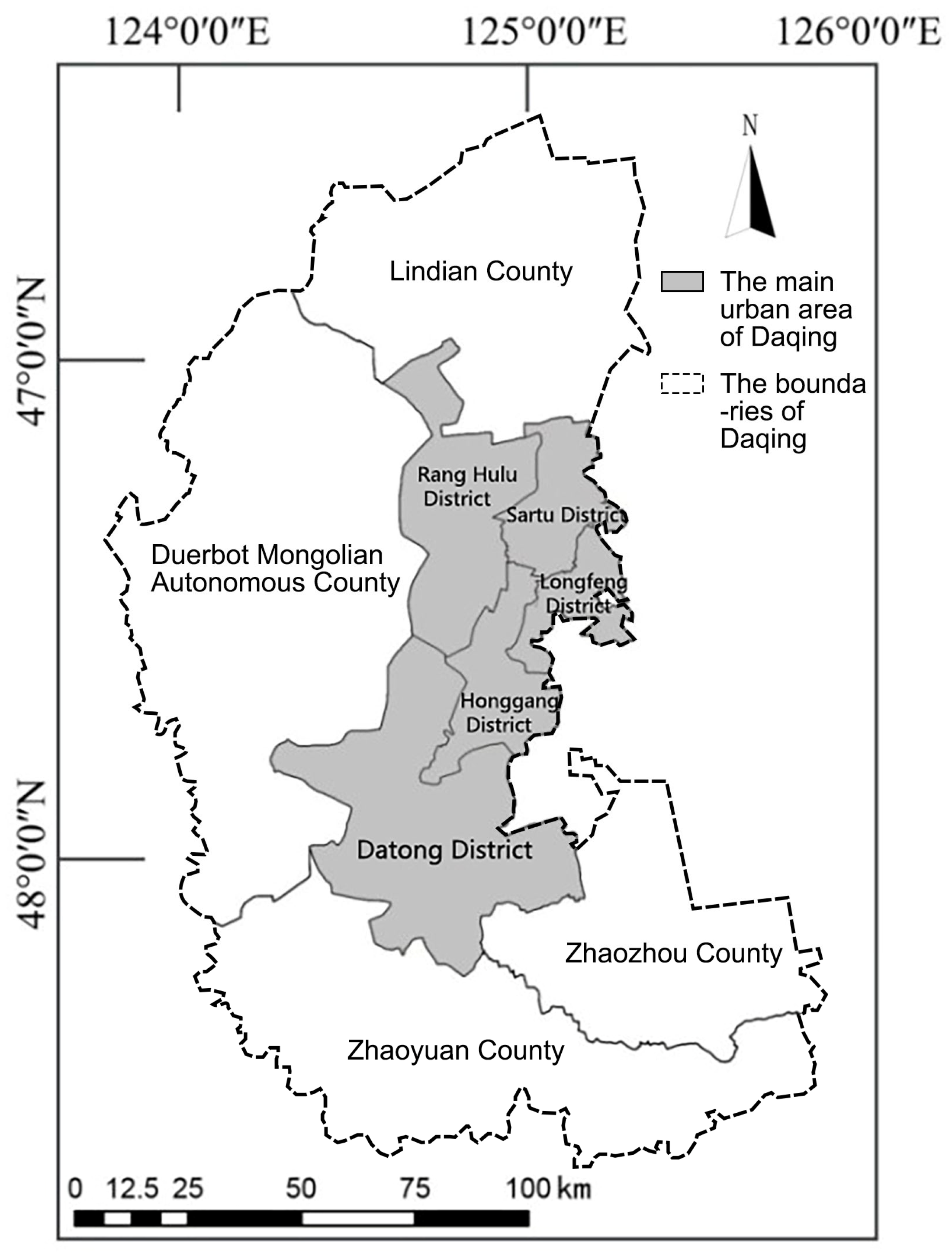

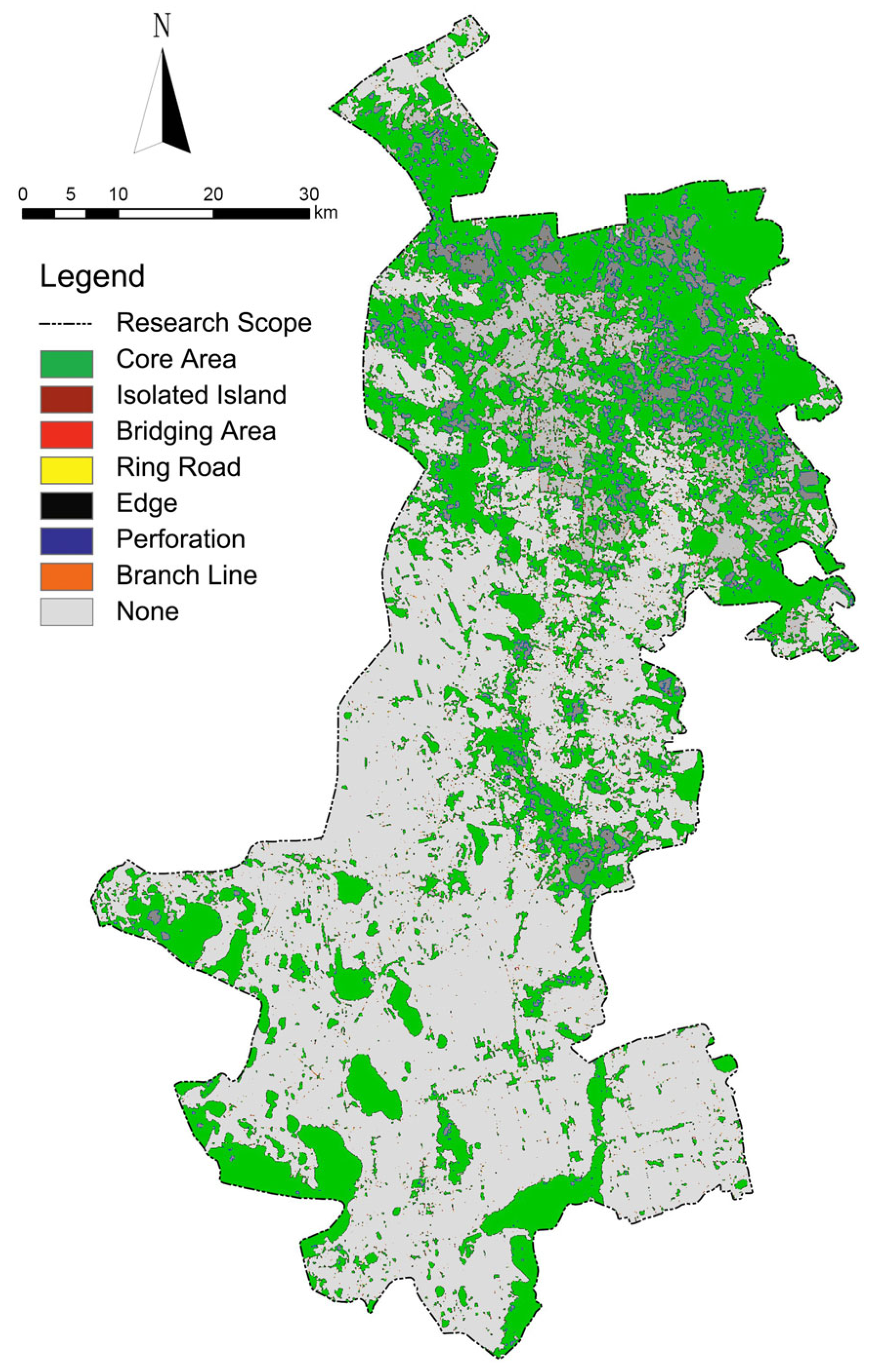
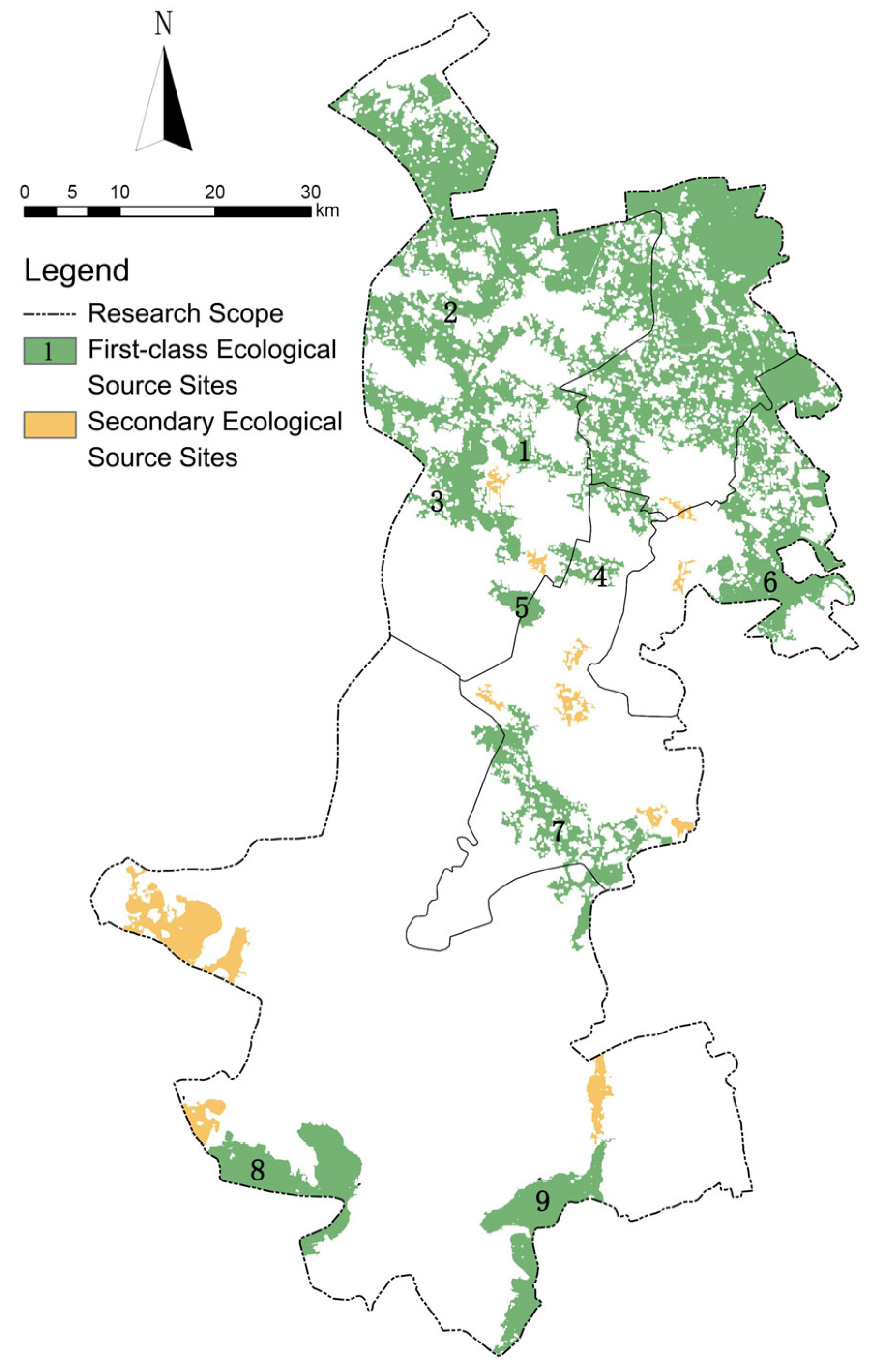
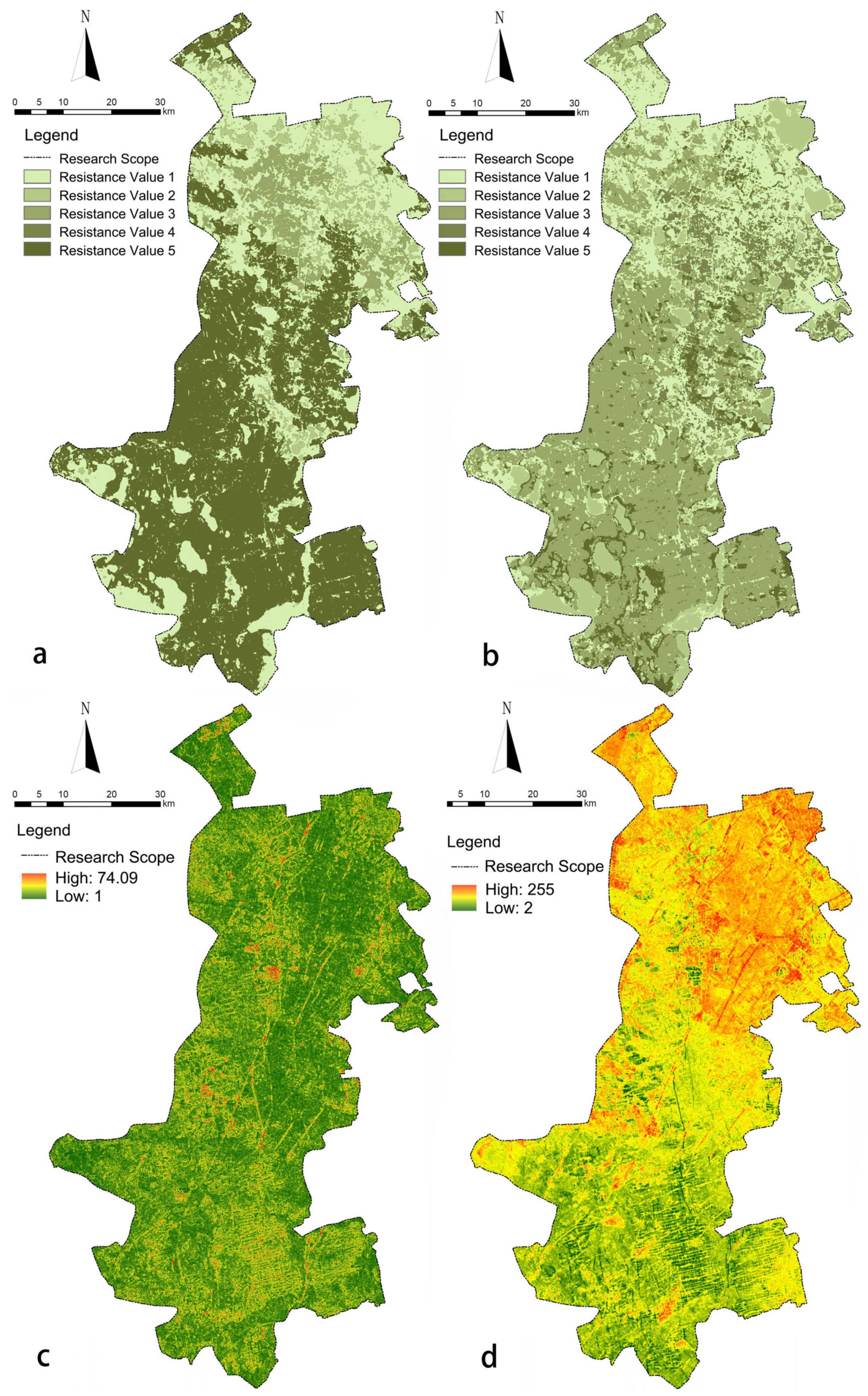


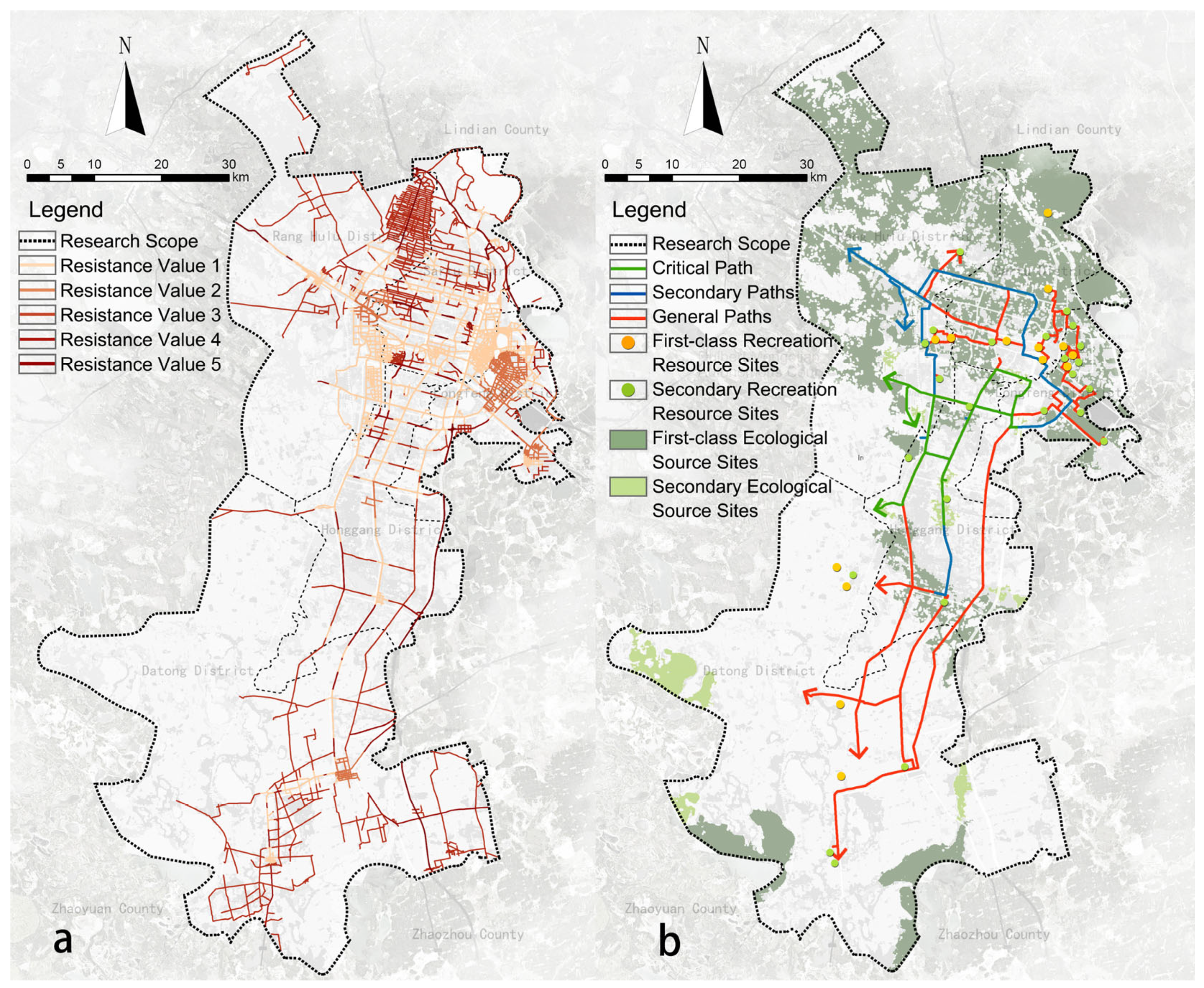
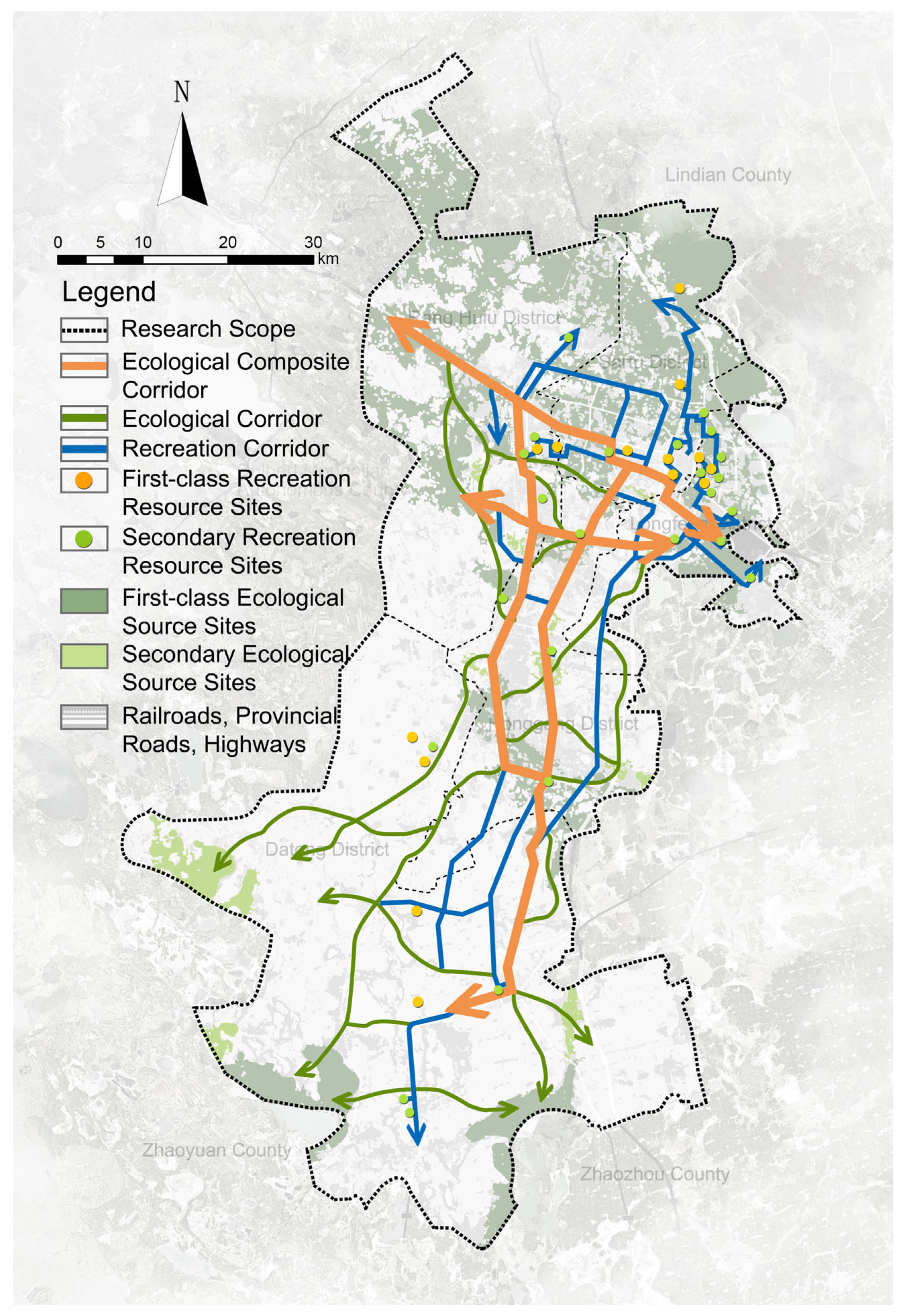
| Target Layer | Indicator Layer | Weight | Classification Standardized | Resistance Value |
|---|---|---|---|---|
| Evaluation of ecological factors in forest ecological corridors | MSPA Landscape type | 0.38 | Core | 1 |
| Bridging | 2 | |||
| Loop | 2 | |||
| Spur | 3 | |||
| Orphan | 3 | |||
| Edge | 4 | |||
| Perforation | 4 | |||
| Land use | 0.27 | Green space | 1 | |
| Water | 2 | |||
| Agricultural land | 3 | |||
| Built-up land | 4 | |||
| Unbuilt Land | 5 | |||
| Elevation | 0.13 | <3° | 1 | |
| 3°–5° | 2 | |||
| 5°–15° | 3 | |||
| 15°–25° | 4 | |||
| >25° | 5 | |||
| Altitude | 0.22 | <100 m | 1 | |
| 100 m–120 m | 2 | |||
| 120 m–150 m | 3 | |||
| 150 m–200 m | 4 | |||
| >200 m | 5 |
| Target Layer | Indicator Layer | Weight | Classification Standardized | Resistance Value |
|---|---|---|---|---|
| Evaluation of recreational factors in forest ecological corridors | Urban road class | 0.4 | Urban secondary roads | 1 |
| Urban Trunk Roads | 3 | |||
| Urban expressway, highway | 5 | |||
| Hub service radius | 0.6 | <500 m | 1 | |
| 500–1000 m | 3 | |||
| >1500 m | 5 |
| Landscape Type | Area | Total Ecological Landscape Area | Total Area |
|---|---|---|---|
| (hm2) | (%) | (%) | |
| Core Area | 165470.67 | 84.50 | 32.77 |
| Isolated Island | 885.96 | 0.45 | 0.18 |
| Bridging | 623.79 | 0.32 | 0.12 |
| Corridor Loop | 313.92 | 0.16 | 0.06 |
| Edge | 20307.69 | 10.37 | 4.02 |
| Perforation | 6365.07 | 3.25 | 1.26 |
| Branch Line | 1861.56 | 0.95 | 0.37 |
| Order | Number | dIIC | dPC | Area | Order | Number | dIIC | dPC | Area |
|---|---|---|---|---|---|---|---|---|---|
| (hm2) | (hm2) | ||||||||
| 1 | 5 | 89.17 | 89.63 | 630.12 | 6 | 36 | 4.41 | 6.13 | 81.97 |
| 2 | 8 | 20.04 | 25.28 | 151.09 | 7 | 1 | 2.13 | 2.86 | 16.22 |
| 3 | 16 | 11.44 | 16.53 | 88.98 | 8 | 55 | 1.04 | 0.84 | 78.39 |
| 4 | 11 | 5.65 | 9.51 | 11.98 | 9 | 56 | 0.90 | 0.76 | 72.47 |
| 5 | 13 | 4.20 | 6.55 | 12.43 | / | / | / | / | / |
Disclaimer/Publisher’s Note: The statements, opinions and data contained in all publications are solely those of the individual author(s) and contributor(s) and not of MDPI and/or the editor(s). MDPI and/or the editor(s) disclaim responsibility for any injury to people or property resulting from any ideas, methods, instructions or products referred to in the content. |
© 2024 by the authors. Licensee MDPI, Basel, Switzerland. This article is an open access article distributed under the terms and conditions of the Creative Commons Attribution (CC BY) license (https://creativecommons.org/licenses/by/4.0/).
Share and Cite
Jing, Z.; Chen, P. Research on the Construction of a Composite Humanistic Forest Ecological Corridor in the Main Urban Area of Daqing City. Sustainability 2024, 16, 3122. https://doi.org/10.3390/su16083122
Jing Z, Chen P. Research on the Construction of a Composite Humanistic Forest Ecological Corridor in the Main Urban Area of Daqing City. Sustainability. 2024; 16(8):3122. https://doi.org/10.3390/su16083122
Chicago/Turabian StyleJing, Zhongwei, and Peng Chen. 2024. "Research on the Construction of a Composite Humanistic Forest Ecological Corridor in the Main Urban Area of Daqing City" Sustainability 16, no. 8: 3122. https://doi.org/10.3390/su16083122
APA StyleJing, Z., & Chen, P. (2024). Research on the Construction of a Composite Humanistic Forest Ecological Corridor in the Main Urban Area of Daqing City. Sustainability, 16(8), 3122. https://doi.org/10.3390/su16083122





